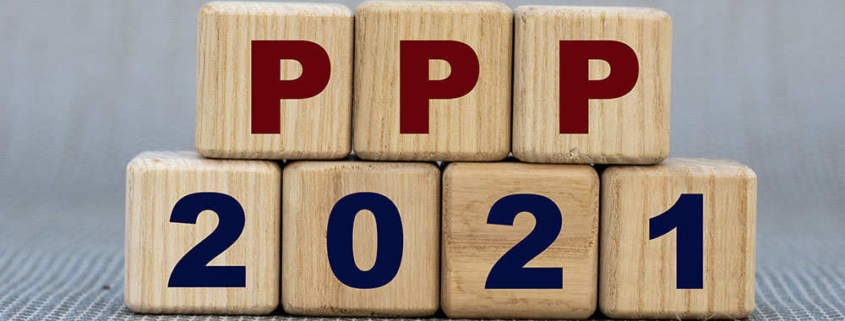What to Know in 2021 About PPP Loans
Many businesses are still struggling due to the financial restrictions imposed due to COVID-19. The severely reduced income combined with ongoing payroll responsibilities has led to many businesses having to shut down entirely. Those that are left standing are hanging on by a thread. Yet, hope is on the horizon. The “Economic Aid to Hard-Hit Small Businesses, Nonprofits, and Venues Act” was recently passed by Congress. This Act reauthorizes the original PPP (Paycheck Protection Program) loans that came to an official end in August of 2020. There’s a lot to know in 2021 about PPP loans.
There are two primary goals for the Economic Aid to Hard-Hit Small Businesses, Nonprofits, and Venues Act. One is to provide needed funding for any small businesses that, for one reason or another, didn’t get a PPP loan in 2020. The second goal is to offer a select group of qualified businesses the opportunity to acquire another PPP loan. If your business falls into one of these categories, you should take the time to learn more about PPP loans in 2021. You have until the end of March, 2021 to avail of the program, or until funds are depleted, whichever comes first. The program is currently available, so you can get your application in immediately. But before you do, it’s important to prepare so that you have the best chances for acceptance.
What to Know About PPP Loans
PPP loans came out as part of the CARES Act, back in April of 2020. This program, administered by the SBA (Small Business Administration), allowed qualified small businesses the chance to get a loan to temporarily cover the costs of payroll. With loan approval, qualified small businesses were able to keep on valued employees through the tough times brought on by the pandemic. So even if a business had to close or have severely limited hours, the PPP loan could enable the business to continue to pay employees for up to eight weeks. While eight weeks doesn’t sound very long, consider the difference between eight weeks with a paycheck and eight weeks without a paycheck. The PPP loan program was not a permanent solution, but it helped. (Note that it was also open to independent contractors.)
The initial program quickly ran out of funding, although it started with a whopping $349 billion available. A further $320 billion was added to help meet ongoing demand.
The key thing to know about PPP loans is that they may be fully or partially forgivable. Unlike other SBA loans, PPP loans do not have to be repaid. The only caveat is that you meet certain requirements. This is a huge benefit to needy small businesses as well as to their employees who ultimately receive the money.
The key things to know about PPP loans in 2021 are:
• Qualified businesses can get PPP loans up to two and a half times their average monthly payroll costs.
• Hospitality and/or food service businesses (i.e., restaurants) with a NAICS code that starts in 72 may qualify for up to three and a half times their average monthly payroll costs.
• The maximum loan amount for businesses that already got one PPP loan in 2020 is $2 million.
• Expanded coverage that meets criteria for loan forgiveness includes:
- Payroll
- Utilities
- Rent
- Mortgage interest payments
- IT/Operations expenses
- Property damage expenses not covered under insurance
- Supplier Expenses
- Worker PPE and general worker safety equipment
• You have to spend a minimum of 60% of the total loan amount on payroll costs
• You have to spend the funds over a period of time of either eight or 24 weeks after the loan origination date.
• You aren’t required to deduct your EIDL advance grant from total of your PPP loan amount forgiveness.
If you did get a PPP loan in 2020, you’ll note that the expanded list of authorized expenses for 2021 PPP loans is quite significant.
Streamlined Loan Forgiveness Application
If you get a 2021 PPP loan for $150,000 or less, you can also take advantage of the new streamlined loan forgiveness application. It’s a simple one-page document that provides the number of employees you were able to keep on due to taking out the loan, an estimate of how much of the loan was spent on payroll, and the total amount of the loan that you got. Unless the SBA needs to verify your business’s revenue loss, that’s all that will be required of you to have your 2021 PPP loan forgiven.
Tax Concerns Regarding the 2021 PPP Loan
You should speak with your CPA about tax concerns regarding the 2021 PPP loan. However, in general, you need to know that your business can’t be brand new; you need to have been operational since February 15th, 2020 at the earliest.
Your business also needs to fall into one of the following four categories:
1. A non-profit or small business with 500 or less employees
2. A small business, 501(c)(19) veteran organization, tribal business, or small agricultural cooperative that meets the SBA’s size standards
3. An independent contractor or sole proprietor
4. A food services or hospitality business that has an NAICS code beginning with the numbers 72, and have fewer than 300 employees per physical location
How to Apply For a 2021 PPP Loan
If you believe your business may qualify for a 2021 PPP loan, you shouldn’t hesitate to apply. The program is already open for applicants. You can apply via the SBA website. Contact your CPA for any needed assistance filling out the application. Be sure to check again with your CPA for the latest information about tax concerns regarding either the 2020 or the 2021 PPP loan program.



